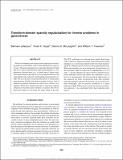Transform-domain sparsity regularization for inverse problems in geosciences
Author(s)
Jarapour, Behnam; Goyal, Vivek K.; McLaughlin, Dennis; Freeman, William T.
DownloadGoyal_Transform-domain.pdf (3.675Mb)
PUBLISHER_POLICY
Publisher Policy
Article is made available in accordance with the publisher's policy and may be subject to US copyright law. Please refer to the publisher's site for terms of use.
Terms of use
Metadata
Show full item recordAbstract
We have developed a new regularization approach for estimating unknown spatial fields, such as facies distributions or porosity maps. The proposed approach is especially efficient for fields that have a sparse representation when transformed into a complementary function space (e.g., a Fourier space). Sparse transform representations provide an accurate characterization of the original field with a relatively small number of transformed variables. We use a discrete cosine transform (DCT) to obtain sparse representations of fields with distinct geologic features, such as channels or geologic formations in vertical cross section. Low-frequency DCT basis elements provide an effectively reduced subspace in which the sparse solution is searched. The low-dimensional subspace is not fixed, but rather adapts to the data.The DCT coefficients are estimated from spatial observations with a variant of compressed sensing. The estimation procedure minimizes an l2-norm measurement misfit term while maintaining DCT coefficient sparsity with an l1-norm regularization term. When measurements are noise-dominated, the performance of this procedure might be improved by implementing it in two steps — one that identifies the sparse subset of important transform coefficients and one that adjusts the coefficients to give a best fit to measurements. We have proved the effectiveness of this approach for facies reconstruction from both scattered- point measurements and areal observations, for crosswell traveltime tomography, and for porosity estimation in a typical multiunit oil field. Where we have tested our sparsity regulariza-tion approach, it has performed better than traditional alter-natives.
Date issued
2009-09Department
Massachusetts Institute of Technology. Department of Civil and Environmental Engineering; Massachusetts Institute of Technology. Department of Electrical Engineering and Computer ScienceJournal
Geophysics
Publisher
Society of Exploration Geophysicists
Citation
Jafarpour, Behnam et al. “Transform-domain sparsity regularization for inverse problems in geosciences.” Geophysics 74.5 (2009): R69. ©2009 Society of Exploration Geophysicists.
Version: Final published version
ISSN
0016-8033
1942-2156